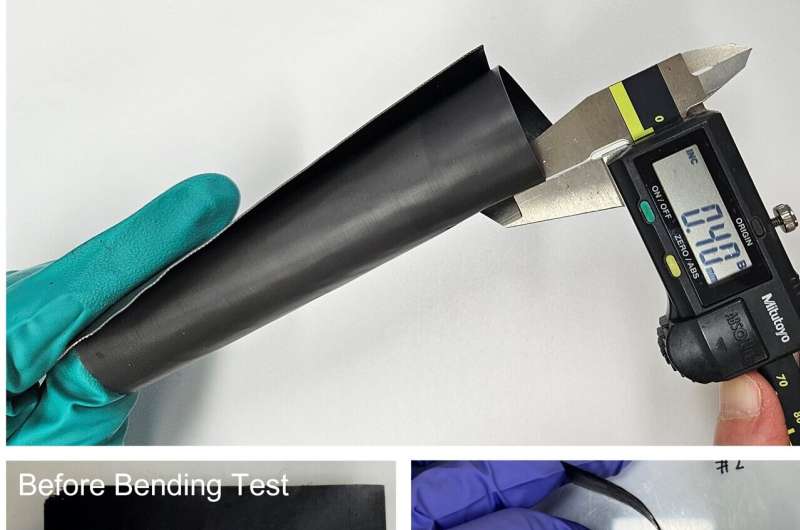Ultra-thin film that absorbs nearly all electromagnetic waves could improve reliability of wireless communication
The research team of Dr. Byeongjin Park and Dr. Sang Bok Lee from the Composites & Convergence Materials Research Division at the Korea Institute of Materials Science (KIMS), has developed the world’s first ultra-thin film composite material capable of absorbing over 99% of electromagnetic waves from various frequency bands (such as 5G/6G, WiFi, and autonomous driving radar) using a single material.
The findings were published as the cover article in the October 1 edition of Advanced Functional Materials.
This electromagnetic wave absorption and shielding material is less than 0.5mm thick and is distinguished by its low reflectance of less than 1% and high absorbance of over 99% across three different frequency bands.
Electromagnetic waves emitted by electronic components can cause interference, leading to performance degradation in other nearby electronic devices.
Electromagnetic shielding materials are used to prevent this, and absorbing electromagnetic waves is more effective at reducing interference than merely reflecting them. However, conventional electromagnetic shielding materials reflect over 90% of the waves, with an actual absorbance often as low as 10%. Moreover, materials with higher absorbance are typically limited to absorbing electromagnetic waves within a single frequency band.
To overcome these limitations, the research team developed a composite material that can absorb electromagnetic waves across multiple frequency bands simultaneously.
This technology absorbs and eliminates electromagnetic waves, resolving secondary interference issues. The material is also thin, flexible, and durable enough to maintain its shape even after being folded and unfolded thousands of times, making it suitable for use in rollable phones and wearable devices.

The team synthesized a magnetic material by altering the crystal structure of ferrite, enabling it to selectively absorb desired frequencies. They produced an ultra-thin polymer composite film and incorporated conductive patterns on the film’s back side to control the propagation of electromagnetic waves.
By adjusting the shape of the conductive pattern, electromagnetic wave reflection at specific frequencies can be dramatically reduced. Additionally, a carbon nanotube thin film with high shielding properties was applied to the back to further enhance the material’s electromagnetic wave shielding capabilities.
Senior researcher Byeongjin Park of KIMS, who led the project, said, “As the applications of 5G/6G communications continue to expand, the importance of electromagnetic wave absorption and shielding materials is growing.”
He added, “This material has the potential to significantly improve the reliability of wireless communication devices such as smartphones and autonomous vehicle radars.”
The research team has completed domestic patent registration and has also applied for patents in the U.S., China, and other countries. Additionally, the technology has been transferred to several domestic material companies, and it is currently being applied to actual communication devices and automobiles.
More information:
Byeongjin Park et al, Absorption‐Dominant Electromagnetic Interference (EMI) Shielding across Multiple mmWave Bands Using Conductive Patterned Magnetic Composite and Double‐Walled Carbon Nanotube Film, Advanced Functional Materials (2024). DOI: 10.1002/adfm.202406197
National Research Council of Science and Technology
Citation:
Ultra-thin film that absorbs nearly all electromagnetic waves could improve reliability of wireless communication (2024, October 28)
retrieved 29 October 2024
from https://techxplore.com/news/2024-10-ultra-thin-absorbs-electromagnetic-reliability.html
This document is subject to copyright. Apart from any fair dealing for the purpose of private study or research, no
part may be reproduced without the written permission. The content is provided for information purposes only.

Comments are closed